
 |
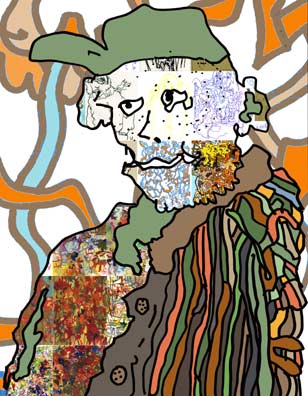
"so, so very what"
Stephen Jay Gould, and his zoologist colleague, Dr. Richard Lewontin, once famously proposed that the architectural structure known as a spandrel is an apt metaphor to explain certain features of evolution. The notion of a spandrel, they suggest, is applicable to structures exhibited by an organism which appear to confer no adaptive benefit. The authors maintain that it is a fallacy to attribute a purpose to every structure an organism manifests.
In a seminal essay, they conclude that the cathedral builders of old, after satisfying the engineering required to construct a cathedral's arches and domes, were left with unavoidable but structurally nonessential spaces, eventually known as spandrels. (Flat wall space created between two adjacent arches is one example).
In biological terms, one especially flamboyant example of a spandrel would be the male peacock's tail. This is nonessential in the extreme. Its size, weight and lack of utility imperil the bird's well-being and survival. Yet, the glorious tails are not eliminated by selective pressure because peacock hens, presumably, get the hots only for the most extravagantly gorgeous plumage.
It would appear that Beauty is the strange attractor of peacock evolution. Viewed this way, the survival of the peacock is the story of a genome in service to Beauty as an end.
The cathedral builders of Europe filled their spandrels with mosaics, frescoes and sculpture. What if the cathedral were thought of as a mere container for said mosaics and frescoes? Viewed this way, the architecture of the cathedral becomes an ingeneous adaptation arrived at in order to provide an opportunity for art to thrive. Beauty is the strange attractor.
The modern age might well turn out to be the artistic equivalent of the Cambrian Explosion - that era of volatile expansion about which Gould so lovingly wrote in his book, "Wonderful Life." Maybe the eruption of various innovative artistic practices in the 20th century - the avante garde, technological innovation, populism - parallel, in our own way, that grand epoch when Mother Nature was furiously at work creating the torrent of experimental forms which (530 million years later) would give us this world enriched with peacocks, cathedrals and theoretically-inclined biologists.
Art rises to fill the non-essential with Beauty and in so doing eliminates the very notion of irrelevance.
There are ripening spandrels aplenty in the artistic practice of our time: neo-paganism, virtual community and sustainablity. The selective pressures of environmental stress, commerce and mediated lcd (lowest common denominator) are accute. Yet, Beauty as guiding imperative remains unassailable.
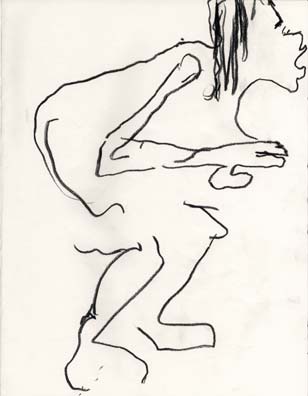
Yoga has lately proven to be a boon to the drawing. Even as a novice (its been about a year now), I've already found that the discipline dislodges the mind from the exclusive province of the head. This provides an opportunity, when drawing a figure, to move attention into the area of the body being drawn. The result is the difference between depicting the appearence of a body versus drawing that body from the experiential inside out.
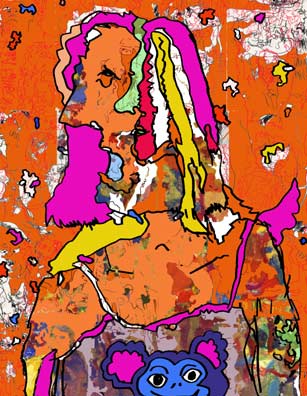
My experience finds it immaterial whether I do or do not begin a work with an intended destination in mind. Simply being attentive and moving the pencil or brush across the surface can bring forth images and resolutions I never ever could have anticipated (as was the case in 2002 when my life's work in Abstract Expressionism shifted to representational imagery seemingly out of the blue). Conversely, and invariably, in those instances when I do start off with a vision, the intended image is quickly (and happily) surrendered to process and rendered unrecognizable. In the end, the original guiding image is fulfilled in the prompt that first set the brush or pencil in motion. Thinking or not thinking, both can improve painting.
The just concluded Terry Winters exhibit at Matthew Marks' 22nd Street gallery was one of those great shows that provides a glimpse of a penetrating artist deeply engaged in the incorporation of new vocabulary and exploration in general.
Many of the works feature the imagery of film strip sprocket holes running across the surface. This depiction seems analogous to Winters' signature imagery of biological cells, but here the shapes imply absence (they're holes after all). The notion of a film strip suggests a sequence of projected images moving past. Intriguingly, the paintings without the explicit slide frame reference have forward planes of biological images that viscerally seem to scroll across the surface in various directions - the film strip is in motion. For genealogcal purposes it would be interesting to learn the sequence in which these paintings were completed.
Topographical maps, stained biological slides, oscilloscope plottings and the aforementioned film strip are a few of the motifs. This raises the question, "What is the scale one is looking at?" Larger than life (there's a phrase to think about) by many magnitudes seems to be the case with most of the works, but some of the fields that consist solely of linear waves, warps and wefts, devoid of floating objects, hint at vast spaces, or (and I'm out on a limb here) psychic portraits. The abstract has become representational, or, if you prefer, the representational has become abstract.
The works deploy a sophisticated game-playing strategy, setting up a system or equation and letting it run. There is a liberation in this way of working that is as palpable on the gallery wall as it, no doubt, is in the studio.
Tacitly circumscribing painterly options allows expression, quirk and randomness to gather by default in the gaps and collapses in the system, thereby drawing attention to themselves. The hand in these paintings is intense, human and stirring of gratitude. Consisting of the incremental accumulation of an innumerable, yet seemingly calculable, number of strokes and decisions, Winters' work, among its many other accomplishments, succeeds in short circuiting its own imagery, becoming a field of communicative touch.
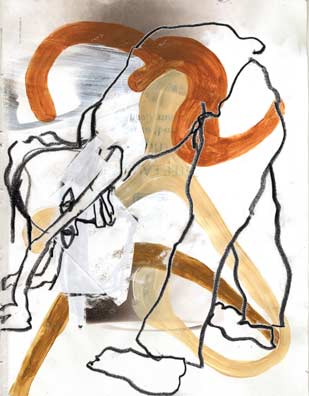
During my student days at the School of the Art Institute of Chicago, professor Dan Gustin once regaled the class with the story of European painting's first contact with the people of Japan. The Japanese response to seeing examples of the Great Western painting tradition was to ask, "why are their faces covered in mud?"
All that chiaroscuro, the flesh tones, brushing and perspective could - in a moment - be revealed as just one in an infinite number of ways to perceive and depict the world. To this day, I find the story compelling and it really hit the spot as a student.
The Japanese use the ground of the paper to represent flesh and the Europeans use the literal ground beneath their feet - pigments composed of pulverized rock and metal and so forth. Contemplating the mutability of reality is a profound pleasure.
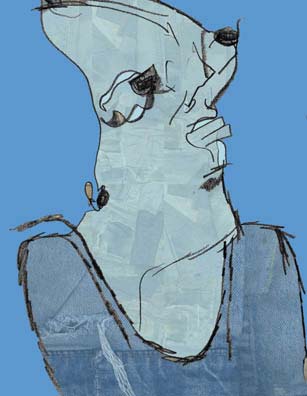
Initially, I was concerned to make this most recent painting THE Web debut. It's a bit of an aberration in the overall body of my work. This, though, begs the question: how can a control group thus far consisting of one item be perceived as aberrational? Maybe aberration will prove to be its own norm.
It comes as a happy congruence of fate that after years of residing in the exploratory phase, the launch of tinsquo.com shares its inauguration with the 100th anniversary of the Wright Brothers' first flight. As a native Daytonian, I grew up in a cultural mileau that told a story where Orville and Wilbur were as Greek gods. Their lives form the defining, shared understanding of what makes the Miami Valley a special place from which to hale. As I'm sure is the case with many people who grew up in Dayton, it did not escape my notice that the Wright Brothers' bicycle shop on West Third St. was as unpresupposing in its day as a contemporary suburban tract house seems in our own. It was an unquestioned thought process of my youth to assume that dwelling within any given house might be a mind at work on some fantastically visionary project destined to change the world. (This, in fact, is not altogether delusional. Dayton has produced an inordinate number of inventors.)
I long ago left the Gem City, but I didn't leave behind the idea that in the nurturance of visions reside the meaning of life. For twenty years, I've been engaged in the practice of painting, trying to do something, something real and impactful. My aesthetic foundation and initial inspiration came from the New York School Abstract Expressionists. Their revelation that process is content guides my work and, in fact, is the principal to which tinsquo is dedicated.
With this site I aim to share the forward edge of my painterly process, to share the traditionally private or inward pursuit of surprise. This is, of course, really the most interesting thing about painting and art. The Web holds the promise of revealing what happens behind closed doors in the remove of the studio and, in so doing, alters what we perceive as valuable and invites others to their own artistry.
One hundred years ago, Orville Wright jumped off a sand dune and in a sense he still hasn't landed. While banking into the wind it's unlikely he was thinking of lunar landings and Hubble telescopes. Most likely he was just hoping not to break his neck and how to improve on the next flight. One thing's for sure, though; my Daytonian forbearers were not bound by the status quo. Their lives would seem to be a refutation of the very notion of a status quo. In a universe of unbound possibilities, we invent the world moment by moment. Invention is human nature. Hence the name of this website, tinsquo -- short for There Is No Status QUO. Welcome.